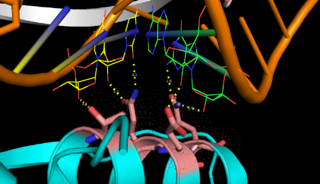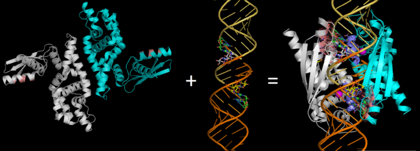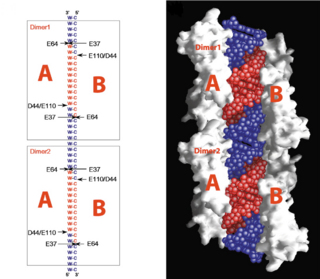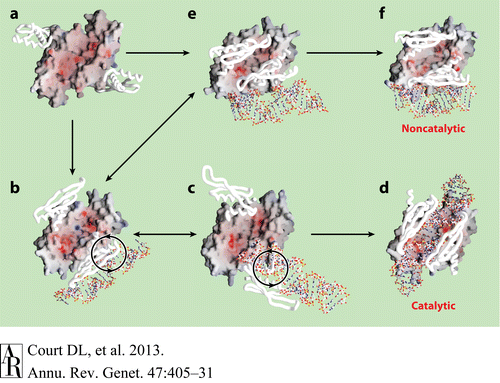Sandbox Reserved 1085
From Proteopedia
(Difference between revisions)
| Line 2: | Line 2: | ||
==Endoribonuclease III== | ==Endoribonuclease III== | ||
<StructureSection load='1O0W' size='420' side='right' caption='Caption for this structure' scene=''> | <StructureSection load='1O0W' size='420' side='right' caption='Caption for this structure' scene=''> | ||
| - | <scene name='69/699998/Ribonuclease_iii/2'> | + | <scene name='69/699998/Ribonuclease_iii/2'>Endoribonuclease III</scene>(RNase III, 2EZ6) is a class 1 RNase III hydrolase enzyme. In general its function, which seems to be universally conserved, is the <scene name='69/699998/Rnase_iii_bound_to_dsrna/2'>RNase III bound to dsRNA</scene> to and cleavage of dsRNA. Endoribonuclease III appears to be crucial for an organisms ability to rapidly adapt to environmental changes through dsRNA processing and decay. |
Universally, it has been shown to mediate RNA turnover at the post-transcriptional level through processing rRNAs, tRNAs, some mRNAs, as well as non-coding dsRNAs. In microbes, RNase III has been shown that it also represses the synthesis of virulence factors (through the cleavage of foreign RNA.) <ref>Lioliou E, Sharma CM, Caldelari I, et al. Global Regulatory Functions of the Staphylococcus aureus Endoribonuclease III in Gene Expression. Hughes D, ed. PLoS Genetics. 2012;8(6):e1002782. doi:10.1371/journal.pgen.1002782</ref> | Universally, it has been shown to mediate RNA turnover at the post-transcriptional level through processing rRNAs, tRNAs, some mRNAs, as well as non-coding dsRNAs. In microbes, RNase III has been shown that it also represses the synthesis of virulence factors (through the cleavage of foreign RNA.) <ref>Lioliou E, Sharma CM, Caldelari I, et al. Global Regulatory Functions of the Staphylococcus aureus Endoribonuclease III in Gene Expression. Hughes D, ed. PLoS Genetics. 2012;8(6):e1002782. doi:10.1371/journal.pgen.1002782</ref> | ||
In eukaryotes, RNase III has also been shown to generate microRNAs and siRNAs, which are central to gene regulation pathways. Model organisms for RNase III include E. coli and Aquifex aeolicus, whose structures have been solved with x-ray crystallography. To study the structure and correlating function of RNase III in more detail, the model obtained from Aquifex aeolicus (Aa-RNase III) will be used. | In eukaryotes, RNase III has also been shown to generate microRNAs and siRNAs, which are central to gene regulation pathways. Model organisms for RNase III include E. coli and Aquifex aeolicus, whose structures have been solved with x-ray crystallography. To study the structure and correlating function of RNase III in more detail, the model obtained from Aquifex aeolicus (Aa-RNase III) will be used. | ||
| - | [[Image: | + | [[Image: Binding site 1.png|thumb|left|320px|Fig.1. ''RNase III binding to dsRNA'' ]] |
== Exploring the Structure == | == Exploring the Structure == | ||
| - | The <scene name='69/699998/Monomer/2'>monomers</scene> of Aquifex aeolicus RNase III (Aa-RNase III) are composed of an <scene name='69/699998/Endond/2'>endonuclease domain</scene> (endoND, green) and a <scene name='69/699998/Dsrbd/4'>dsRNA binding domain</scene> (dsRBD, red)<ref>Lamontagne, B., et al., The RNase III family: a conserved structure and expanding functions in eukaryotic dsRNA metabolism. Yeast, 2001. 45(191): p. 154-158.</ref>. The sequence of the endoND is characterized by a stretch of conserved residues (37ERLEFLGD44 in Aa-RNase III), which is known as the RNase III <scene name='69/699998/Sig_motiff/2'>signature motif</scene> and makes up a large part of the active center, where catalysis takes place. RNase III hydrogen-bonds to dsRNA with residues T154,Q157,E158,Q161, which make up the binding site (''Fig.1''). RNase III can affect gene expression in either of two ways: as a processing enzyme which RNase III cleaves both natural and synthetic dsRNA into small duplex products averaging 10–18 base pairs in length, or as a binding protein which binds and stabilizes certain RNAs, thus suppressing the expression of certain genes[<ref>Robertson, H.D., Escherichia coli ribonuclease III cleavage sites. Cell, 1982. 30(3): p. 669-672.</ref>, <ref>Grunberg-Manago, M., Messenger RNA stability and its role in control of gene expression in bacteria and phages. Annual review of genetics, 1999. 33(1): p. 193-227.</ref>]. | + | The <scene name='69/699998/Monomer/2'>monomers</scene> of Aquifex aeolicus RNase III (Aa-RNase III) are composed of an <scene name='69/699998/Endond/2'>endonuclease domain</scene> (endoND, green) and a <scene name='69/699998/Dsrbd/4'>dsRNA binding domain</scene> (dsRBD, red)<ref>Lamontagne, B., et al., The RNase III family: a conserved structure and expanding functions in eukaryotic dsRNA metabolism. Yeast, 2001. 45(191): p. 154-158.</ref>. The sequence of the endoND is characterized by a stretch of conserved residues (37ERLEFLGD44 in Aa-RNase III), which is known as the RNase III <scene name='69/699998/Sig_motiff/2'>signature motif</scene>(purple) and makes up a large part of the active center, where catalysis takes place. RNase III hydrogen-bonds to dsRNA with residues T154,Q157,E158,Q161, which make up the binding site (''Fig.1''). RNase III can affect gene expression in either of two ways: as a processing enzyme which RNase III cleaves both natural and synthetic dsRNA into small duplex products averaging 10–18 base pairs in length, or as a binding protein which binds and stabilizes certain RNAs, thus suppressing the expression of certain genes[<ref>Robertson, H.D., Escherichia coli ribonuclease III cleavage sites. Cell, 1982. 30(3): p. 669-672.</ref>, <ref>Grunberg-Manago, M., Messenger RNA stability and its role in control of gene expression in bacteria and phages. Annual review of genetics, 1999. 33(1): p. 193-227.</ref>]. |
| - | [[Image: | + | [[Image: ALIGN2.png|thumb|left|420px|Fig.2. ''RNase III (Pbd codes 1O0W & 2EZ6) conformation change when bound to dsRNA'' ]] |
[[Image: Cleavage site of RNase III.png|thumb|right|320px|Fig.3. ''cleavage site of Aa-RNase III'' ]] | [[Image: Cleavage site of RNase III.png|thumb|right|320px|Fig.3. ''cleavage site of Aa-RNase III'' ]] | ||
Revision as of 14:36, 23 April 2015
| This Sandbox is Reserved from 15/04/2015, through 15/06/2015 for use in the course "Protein structure, function and folding" taught by Taru Meri at the University of Helsinki. This reservation includes Sandbox Reserved 1081 through Sandbox Reserved 1090. |
To get started:
More help: Help:Editing |
Endoribonuclease III
| |||||||||||
References
- ↑ Lioliou E, Sharma CM, Caldelari I, et al. Global Regulatory Functions of the Staphylococcus aureus Endoribonuclease III in Gene Expression. Hughes D, ed. PLoS Genetics. 2012;8(6):e1002782. doi:10.1371/journal.pgen.1002782
- ↑ Lamontagne, B., et al., The RNase III family: a conserved structure and expanding functions in eukaryotic dsRNA metabolism. Yeast, 2001. 45(191): p. 154-158.
- ↑ Robertson, H.D., Escherichia coli ribonuclease III cleavage sites. Cell, 1982. 30(3): p. 669-672.
- ↑ Grunberg-Manago, M., Messenger RNA stability and its role in control of gene expression in bacteria and phages. Annual review of genetics, 1999. 33(1): p. 193-227.
- ↑ 5.0 5.1 Gan, J., et al., Intermediate states of ribonuclease III in complex with double-stranded RNA. Structure, 2005. 13(10): p. 1435-1442.
- ↑ Blaszczyk, J., et al., Noncatalytic assembly of ribonuclease III with double-stranded RNA. Structure, 2004. 12(3): p. 457-466.
- ↑ Blaszczyk, J., et al., Crystallographic and modeling studies of RNase III suggest a mechanism for double-stranded RNA cleavage. Structure, 2001. 9(12): p. 1225-1236
- ↑ Blaszczyk, J., et al., Noncatalytic assembly of ribonuclease III with double-stranded RNA. Structure, 2004. 12(3): p. 457-466
- ↑ Gan, J., et al., Structural insight into the mechanism of double-stranded RNA processing by ribonuclease III. Cell, 2006. 124(2): p. 355-66




